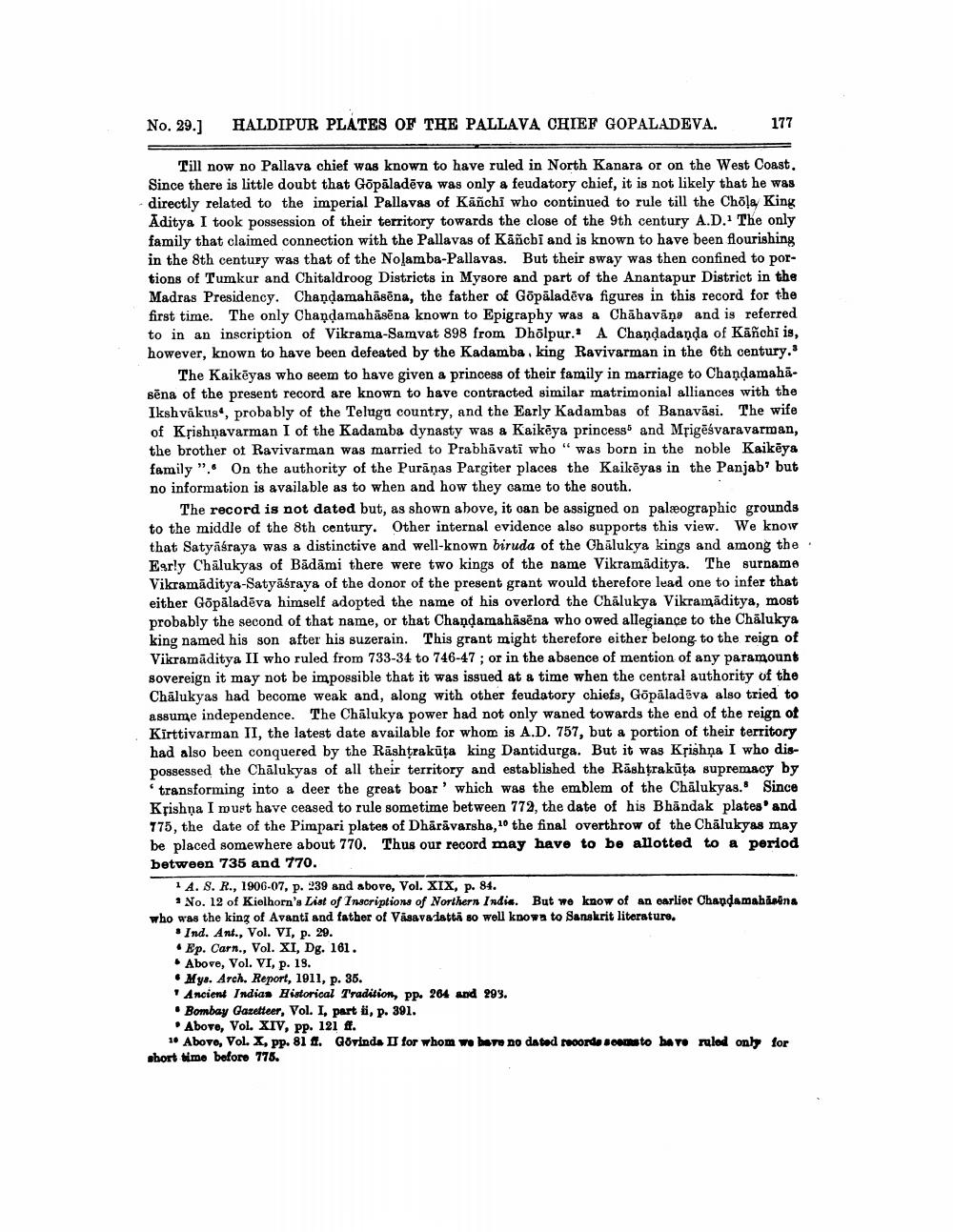________________
No. 29.]
HALDIPUR PLATES OF THE PALLAVA CHIEF GOPALADEVA.
177
Till now no Pallava chief was known to have ruled in North Kanara or on the West Coast. Since there is little doubt that Gõpāladēva was only a feudatory chief, it is not likely that he was directly related to the imperial Pallavas of Kanchi who continued to rule till the Chola King Aditya I took possession of their territory towards the close of the 9th century A.D. The only family that claimed connection with the Pallavas of Kāñcbi and is known to have been flourishing in the 8th century was that of the Nolamba-Pallavas. But their sway was then confined to portions of Tumkur and Chitaldroog Districts in Mysore and part of the Anantapur District in the Madras Presidency. Chandamahāsēna, the father of Gõpāladeva figures in this record for the first time. The only Chandamahäsēna known to Epigraphy was a Chāhavāne and is referred to in an inscription of Vikrama-Samvat 898 from Dholpur. A Chandadanda of Kanchi is, however, known to have been defeated by the Kadamba king Ravivarman in the 6th century."
The Kaikėyas who seem to have given a princess of their family in marriage to Chandamahā. sēna of the present record are known to have contracted similar matrimonial alliances with the Iksh vākus, probably of the Teluga country, and the Early Kadambas of Banavāsi. The wife of Krishnavarman I of the Kadamba dynasty was & Kaikēya princess and Msigēśvaravarman, the brother of Ravivarman was married to Prabhāvati who " was born in the noble Kaikėya family". On the authority of the Purāņas Pargiter places the Kaikēyas in the Panjab? but no information is available as to when and how they came to the south.
The record is not dated but, as shown above, it can be assigned on palæographic grounds to the middle of the 8th century. Other internal evidence also supports this view. We know that Satyāśraya was a distinctive and well-known biruda of the Chalukya kings and among the Egrly Chālukyas of Bādāmi there were two kings of the name Vikramaditya. The surname Vikramāditya-Satyäsraya of the donor of the present grant would therefore lead one to infer that either Göpäladeva himself adopted the name of his overlord the Chalukya Vikramaditya, most probably the second of that name, or that Chandamahāsēna who owed allegiance to the Chālukya king named his son after his suzerain. This grant might therefore either belong to the reign of Vikramaditya II who ruled from 733-34 to 746-47 ; or in the absence of mention of any paramount sovereign it may not be impossible that it was issued at a time when the central authority of the Chālukyas had become weak and, along with other feudatory chiefs, Göpāladeva also tried to assume independence. The Chalukya power had not only waned towards the end of the reign of Kirttivarman II, the latest date available for whom is A.D. 757, but a portion of their territory had also been conquered by the Rashtrakūta king Dantidurga. But it was Krishna I who dispossessed the Chalukyas of all their territory and established the Rashtrakūta supremacy by
transforming into a deer the great boar' which was the emblem of the Chalukyas. Since Kfishņa I must have ceased to rule sometime between 772, the date of his Bhāndak plates and 775, the date of the Pimpari plates of Dhärāvarsha, 10 the final overthrow of the Chālukyas may be placed somewhere about 770. Thus our record may have to be allotted to a period between 735 and 770.
1 A. S. R., 1906-07, p. 239 and above, Vol. XIX, p. 84.
: No. 12 of Kiolhorn's List of Inscriptions of Northern India. But we know of an earlier Chapdamahisina who was the king of Avanti and father of Vasava latti so well known to Sanskrit literaturo.
• Ind. Ant., Vol. VI, p. 29. • Ep. Carn., Vol. XI, Dg. 161.
Above, Vol. VI, p. 19. • Mys. Arch. Report, 1911, p. 35.
Ancient Indias Historical Tradition, pp. 264 and 299. • Bombay Gazetteer, Vol. I, part i, p. 391. . Above, Vol. XIV, pp. 121 ft.
1. Abovo, Vol. X, pp. 81 . Govinda IJ for whom where no dated rooorde sooms to havo ruled only for short time before 778.




